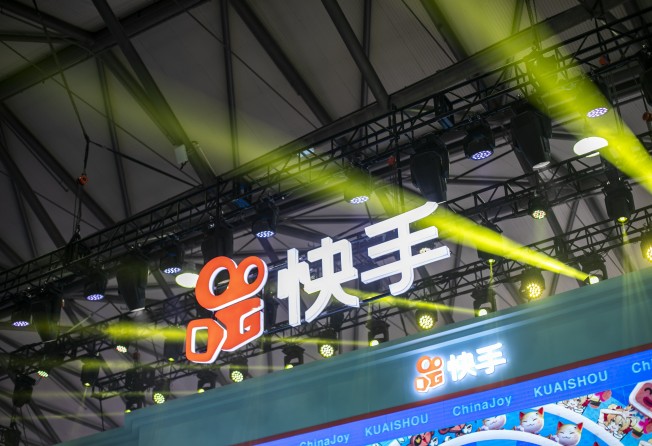
IPO-prospect Kuaishou has a big issue – how to bag a profit from the 300 million who use its short video app
- Kuaishou’s model has been criticised by some analysts for an over-reliance on celebrity influencers and a costly user acquisition strategy
- Others argue short video app needs time to build its ecosystem and cash burn to acquire users is a well-trodden path by successful tech start-ups

Kuaishou, the Chinese short video app operator set for an IPO in Hong Kong as early as this month, has a big issue – how to translate its 300 million daily active users into profits.
The app, which competes with ByteDance’s Douyin for eyeballs and whose name means ‘speedy hand’, allows users to upload and share short videos and about one-in-three of China’s netizens use it at least once a day.
But according to preliminary financial filings the Beijing-based company chalked up a net loss of 68 billion yuan (US$10.53 billion) in the first six months of 2020 – roughly 373 million yuan of losses a day – which means investors have to weigh up the cost of acquiring new users against how quickly the business can build a path to long-term profitability.
China had 818 million short video users as of end-June 2020, according to a report released by the China Netcasting Services Association in October. Douyin and Kuaishou are the two dominant players, although WeChat’s short video function Channels is catching up quickly, reaping the advantages of WeChat’s huge user base.
Douyin, the Chinese version of Tiktok, had 600 million daily active users by August 2020 but the company has yet to publish financial figures. Reuters reported in November that ByteDance generated at least 180 billion yuan in ad revenue in China last year, with Douyin contributing nearly 60 per cent of that.
“Many of Kuaishou’s new users have low-to-no ARPU (average revenue per user), meaning that costs escalate with very little monetisation,” said Mark Tanner, managing director at Shanghai-based consultancy China Skinny. “However, user acquisition has historically been the most important goal of China’s fast-growing tech companies pre-IPO and will be looked upon fondly at listing.”
Aggressive user acquisition, often referred to as “blitzscaling”, has been a common tactic for tech start-ups.
Meituan piled up billions of yuan in losses to acquire market share ahead of its Hong Kong IPO in 2018, worrying some investors. But its shares are currently trading at over four times its list price after the online services giant turned in a strong profit in the second quarter of 2020, bouncing back on a pandemic-fuelled boom.
Kuaishou did not immediately respond to a request for comment on this story.
Su Hua, chief executive of Tencent-backed Kuaishou, was born in 1982 and graduated from the prestigious Tsinghua University. The company, initially launched in 2011 as a tool for creating animated GIFs, has taken its time to build its business and come to market.
The IPO is expected to raise between US$5 billion and US$8 billion, which would make it one of the biggest IPOs in Hong Kong since Alibaba‘s US$13 billion secondary listing in November 2019.
At the beginning of 2018, only 10 per cent of users could view adverts on the platform. That proportion increased to 60 per cent by October 2018, according to a report by Shanghai-based brokerage Orient Securities. Live-streaming contributed most of its revenue in the early years, accounting for 95.3 per cent of overall turnover in 2017 and 91.7 per cent in 2018, according to its prospectus.
To explore new ways of making money, Kuaishou began live-streaming e-commerce in August 2018 – selling goods via its key opinion leaders and masters of celebrations on the platform. As a result, gross merchandise value (GMV) ballooned from 97 million yuan in 2018 to 109.6 billion yuan in the first half of 2020.
However, the live-steaming model has been criticised by some analysts for an over-reliance on celebrity influencers.
Xinba, a popular 30-year old online idol known as the No. 1 Brother on Kuaishou, once sold 1.25 billion yuan worth of products in a single live-streaming show – showing his ability to turn fans into buyers. By 2019, he accounted for just over a fifth of Kuaishou’s total GMV.
However, Xinba’s reputation came under fire late last year after Guangzhou’s market watchdog found that he had promoted bird’s nest – an expensive Chinese delicacy – that was actually just sugar and water, resulting in a fine of 900,000 yuan for endorsing fake products. Kuaishou blocked Xinba from live-streaming for 60 days.

Xinba apologised and offered consumers compensation of up to three times their purchases. But the jury is out on whether the online celebrity can win back public trust after video tapes surfaced online last month, showing consumer groups protesting in front of his office over the scandal and related issues.
The case has underlined the risks of a business model that relies on fickle celebrity power – alongside the aggressive cash burn strategy – and this has left analysts divided.
Daily active users on Kuaishou’s main app grew to an average 258 million by the end of June 2020, but this growth came with marketing costs – such as being the exclusive “red packet” partner of the 2020 Spring Festival Gala in January, during which the app gave out 1 billion yuan in digital red packets.
Zhang Yi, chief executive of research firm iiMedia, said his firm’s research on Chinese cities found that only 20 per cent of people were loyal to Kuaishou, with stronger loyalty of almost 80 per cent for competitor Douyin, which has 600 million daily active users.
“This means the ‘blood transfusion’ has not achieved a virtuous circle, which could mean big trouble. Take [ride-hailing company] Didi Chuxing for example, at least it gained market share after burning through cash,” said Zhang. “If your artery is cut and you cannot stop the bleeding – a blood transfusion is not going to save you.”
But Zhang Dingding, an internet industry commentator and former head of Beijing-based research firm Sootoo Institute, said Kuaishou is not rushing to make money from e-commerce because it “wants to build the ecosystem first” and “leave the profit to others in the supply chain” at this stage.
“For Kuaishou, building an ecosystem [around short video and live streaming] is more important than making a quick profit. So I don’t think a loss [at this stage] is terrible. What would be terrible is if you don’t get growth after cash burn, but it seems like Kuaishou has not reached its ceiling yet,” he said.
While Kuaishou and Douyin have some user overlaps, their audience profiles are broadly distinct.
A typical Douyin user is a consumer living in a first-tier Chinese city who was born in the 1980s or 1990s with a high school education as a minimum. In contrast, a typical Kuaishou user is a teenager living in a small Chinese town who was born after 2000, with only a junior middle school education, according to a recent report by the China Netcasting Services Association.
China Skinny’s Tanner said that Kuaishou’s biggest opportunity is to further penetrate the smaller Chinese cities that have not been cherry-picked yet by bigger short video and e-commerce platforms. He acknowledged that this could be difficult though as this segment “is the most challenging to generate higher [revenue from]”.
Regulation is another potential problem as Beijing up its scrutiny of live-streaming and online content in order to protect consumers. The central government has already issued rules requiring live-streaming platforms to be held accountable for product quality sold by vendors, for example.
And as it prepares for its IPO, Kuaishou launched a campaign to clean up “soft porn” content in mid-November, saying it had punished 8,900 accounts by the end of 2020. Kuaishou states in the IPO prospectus that stricter regulatory requirements could restrict its business, leaving investors to calculate the risks.
“The Xinba incident was quite a blow to Kuaishou, not only in terms of loss of sales during the suspension, but also in terms of the damage done to its reputation as a shopping platform,” said iiMedia’s Zhang.